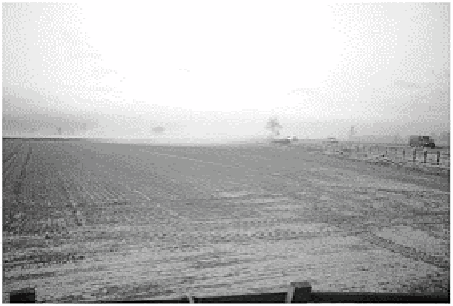Environmental Engineering Reference
In-Depth Information
sands, loamy sands, loams and silts, which are widespread in southern and eastern
England. Wind erosion is a problem for the sands, loamy sands and sandy loams of
Lincolnshire, Yorkshire and East Anglia (Plate 1). The content of fine sand seems to be a
crucial factor in making soils erodible, and organic matter gives them more stability.
Unfortunately intensive cultivation for the main cash crops of cereals, sugar beet,
potatoes and vegetables depletes organic matter, and there is a need to develop systems of
crop and soil management to minimize erosion.
Plate 1
Sandy soils in the Vale of York of northern England are
susceptible to erosion by strong winds, especially when the soil
surface is not protected by a cover of crops.
Photo: Ken Atkinson.
During the 1930s wind erosion reached crisis proportions in the United States and
Canada when huge clouds of dust from the Dust Bowl of the prairies darkened the skies
of the eastern United States. A series of drier than normal years led to crop failures on
marginal land cultivated by techniques appropriate to more humid regions. Unprotected
topsoils dried out, lost their structural stability and simply blew away. At the same time,
more humid parts of the United States, especially in the south, reported severe water
erosion with the same underlying cause, namely the breakdown of soil structure, resulting
in lower infiltration rates, more overland flow and consequent erosion and flooding.
Since the 1930s erosion has been a matter of public concern, and in general conditions
have improved in More Economically Developed Countries (MEDCs), where large
investments have been made in soil conservation techniques, but the crisis is still present
in Less Economically Developed Countries (LEDCs), where population growth continues
to fuel land clearance and greater pressure on marginal land. Examples of soil erosion in
different environments are found in Chapters 26, 27 and 28.
It is difficult to quantify erosion rates and their negative impacts on crop yields, and
many of the estimates derive from models rather than from field measurements. The most
widely used model is the
universal soil loss equation
(USLE) developed by the US






